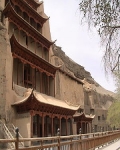Mogao Caves
Archaeology »
Archaeological Monuments » Mogao Caves
Mogao Caves -
Mogao Caves is located in Silk Road -Gansu.
Mogao Caves monument was established on 1900 .
Primary threats to Mogao Caves :
Historical facts of Mogao Caves :
- The Mogao Caves, also known as the Thousand Buddha Grottoes, are a UNESCO World Heritage Site located near the city of Dunhuang in Gansu Province, China. These ancient caves are renowned for their exquisite Buddhist art and serve as a testament to the cultural and historical significance of the Silk Road. Here are some historical facts about the Mogao Caves:
- Construction and Origins : The construction of the Mogao Caves began in the 4th century AD and continued for over a millennium. The caves were carved out of the cliffside by Buddhist monks, who sought to create sacred spaces for meditation, worship, and the preservation of Buddhist texts.
- Silk Road Connection : Dunhuang, the city near the Mogao Caves, was a vital stop along the ancient Silk Road trade route. The caves flourished due to the cultural exchange and patronage by traders, pilgrims, and travelers from different regions, resulting in the convergence of various artistic styles and influences.
- Extensive Cave Complex : The Mogao Caves consist of 492 caves, with over 2,000 painted sculptures and 45,000 square meters of wall paintings. The caves vary in size, with some as small as a room and others as vast as a multi-story building. They collectively form an unparalleled treasure trove of Buddhist art and religious artifacts.
- Preservation of Buddhist Texts : The Mogao Caves are also known as the "Library Cave" due to the discovery of a hidden chamber in 1900. This chamber, known as Cave 17 or the "Cave of a Thousand Buddhas," contained a vast collection of Buddhist texts and manuscripts dating back to the 5th century. These texts, now collectively known as the Dunhuang Manuscripts, provide invaluable insights into various aspects of ancient Chinese, Central Asian, and Indian cultures.
- Influence of Different Dynasties : The Mogao Caves reflect the artistic styles and influences of multiple dynasties that ruled over China. The artwork in the caves showcases the development of Buddhist art over the centuries, encompassing elements from the Northern Wei, Sui, Tang, Five Dynasties, Song, Western Xia, and Yuan dynasties.
- Wall Paintings and Sculptures : The wall paintings in the Mogao Caves depict scenes from Buddhist scriptures, celestial beings, bodhisattvas, and other religious figures. The sculptures range from small statues to large freestanding figures, showcasing the skill and artistry of the craftsmen who worked on the caves.
- Rediscovery and Conservation : The Mogao Caves experienced a period of neglect and abandonment after the decline of the Silk Road. However, they were rediscovered in the early 20th century and efforts were made to protect and preserve the caves and their artwork. The Dunhuang Research Academy was established in 1944 to oversee the conservation and research of the site.
- Cultural Significance : The Mogao Caves are considered a pinnacle of Buddhist art and have played a crucial role in spreading Buddhism across East Asia. The artwork within the caves reflects the fusion of diverse cultural and artistic traditions, making them an important testament to the historical and cultural exchanges that took place along the Silk Road.
- UNESCO World Heritage Site : The Mogao Caves were inscribed as a UNESCO World Heritage Site in 1987. The site's significance lies not only in its artistic and religious value but also in its representation of the global interconnectedness fostered by the Silk Road.
- Visitor Experience : Today, visitors can explore a limited number of caves open to the public, with rotating exhibitions to protect the delicate artwork. The Mogao Caves continue to attract tourists and scholars from around the world, offering a glimpse into the rich history and cultural heritage of the Silk Road and Buddhism.
- In conclusion, the Mogao Caves in Dunhuang, China, stand as a testament to the rich history and cultural significance of the Silk Road. With their extensive collection of Buddhist art, preservation of ancient texts, and influence from multiple dynasties, the caves serve as a vital link to China's past and offer a glimpse into the artistic and religious traditions of the region. The Mogao Caves remain a mesmerizing destination for those seeking to immerse themselves in the beauty and historical significance of this remarkable site.

